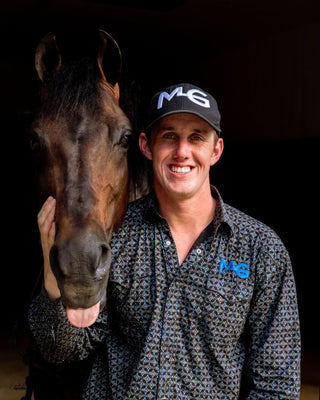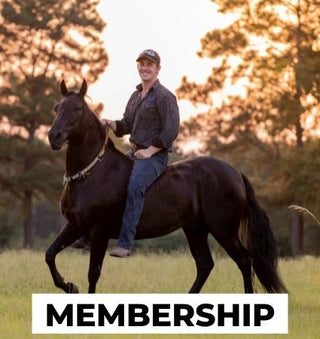Watch the Video Here or continue reading below!
Getting your gaited horse to move faster while maintaining a smooth, controlled gait is all about technique, positioning, and confidence. Whether you're working with a Paso Fino, Tennessee Walker, or any other gaited breed, the key to increasing speed is proper body positioning, engagement, and training consistency. In this guide, we'll break down the step-by-step process to help your horse cover more ground while staying balanced and comfortable.
Before You Start: Build a Solid Foundation
Before working on increasing speed, your horse must have a strong foundation in training. This includes:
✔️ Softness and responsiveness in the bridle
✔️ Respect and focus on the rider
✔️ A consistent, balanced gait at slower speeds
If your horse isn’t already moving in a steady gait, focus on groundwork, obstacles, and respect training first. Once you have that consistency, it’s time to build speed.
The Key to Speed: Straight Lines vs. Circles
One of the biggest factors in a horse’s speed is how they are directed:
-
🔄 Small Circles = Slower Speed – The tighter the circle, the harder it is for a horse to move fast. If your horse is rushing, smaller circles can help slow them down.
-
➡️ Straight Lines = Faster Speed – To encourage speed, work in straight lines. A fence line or rail is a great tool for this exercise.
If you're training in a small space (like a show ring), you can still increase speed by riding along the rail and using specific techniques to maintain momentum.
Step 1: Start in a Consistent Gait
Begin by establishing a smooth, steady gait at a moderate speed. If you're working with a Paso Fino, this will be the Corto (short gait). For other gaited horses, it may be the running walk or foxtrot. Keep the horse moving forward in a comfortable rhythm before asking for more speed.
Step 2: Engage the Hindquarters for More Drive
To increase speed, you need to drive the horse forward from behind while keeping them balanced. Here's how:
✅ Sit Back & Squeeze – Lean back slightly and apply steady leg pressure to encourage forward movement.
✅ Use Your Inside Leg – If riding on the rail, use your leg opposite the fence to push the horse forward and keep their hindquarters engaged.
✅ Keep the Nose Tipped Slightly Inward – This helps the horse feel more confident while maintaining direction.
Step 3: Manage Your Rein Contact
One common mistake riders make is dropping the reins when asking for speed. While it might seem natural to give the horse more freedom, this actually causes them to lose balance and break gait.
🚫 Don’t throw away the reins! Instead, maintain a light but steady contact, encouraging the horse to drive into the bridle. This keeps the back end engaged and prevents them from hollowing out or losing rhythm.
Step 4: Navigating Corners Without Slowing Down
If you’re working in a ring, you’ll encounter corners where the horse may want to slow down. To keep them moving:
✔️ Lean into the turn rather than pulling with the inside rein.
✔️ Allow the horse to round the corner naturally without abrupt direction changes.
✔️ Keep driving with your inside leg to maintain engagement and power.
Step 5: Transitioning Between Speeds
Once your horse is confidently moving at a faster gait, work on smooth transitions:
🔹 Increase speed by squeezing your legs and maintaining rein contact.
🔹 Slow down by gently sitting deeper and reducing leg pressure.
🔹 Use half-halts to adjust speed without breaking gait.
Pro Tip: A well-trained gaited horse should be able to move fluidly between speeds while staying relaxed and comfortable.
Final Thoughts: Build Confidence and Consistency
By using these techniques consistently, your horse will gain confidence and drive in their gait. The more comfortable they become, the easier it will be to increase speed while maintaining balance.
🐴 Key Takeaways:
✔️ Use straight lines to encourage speed.
✔️ Engage the hindquarters with your legs and seat.
✔️ Maintain light rein contact to prevent breaking gait.
✔️ Navigate corners smoothly by leaning in rather than pulling.
✔️ Practice transitions to develop control at all speeds.
With practice, your gaited horse will be moving faster, smoother, and more efficiently. A happy, confident horse equals a better ride!
Thanks for reading, and happy riding! 🐎









